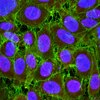Neutralization of malaria GPI in vitro by serum IgG from malaria exposed individuals.
de Souza JB, Runglall M, Corran PH, Okell LC, Kumar S, Gowda DC, Couper KN, Riley EM
Infect Immun
2010
Show Abstract
Parasite-derived glycosylphosphatidylinositol (GPI) is believed to be a major inducer of the pathways leading to pathology and morbidity during malaria infection and has been termed a malaria "toxin". The generation of neutralising anti-GPI ("anti-toxic") antibodies has, therefore, been hypothesised to be an important step in the acquisition of anti-disease immunity to malaria; however to date the GPI-neutralising capacity of antibodies induced during natural malaria infection has not been evaluated. Here we describe the development of an in vitro macrophage-based assay to assess the neutralising capacity of malarial GPI-specific IgG. We demonstrate that IgG from Plasmodium falciparum-exposed individuals can significantly inhibit GPI-induced activation of macrophages in vitro, as shown by reduced TNF production and attenuation of CD40 expression. The GPI neutralising capacity of individual IgG samples was directly correlated with anti-GPI antibody titre. IgG from malaria-exposed individuals also neutralised the macrophage activating effects of P. falciparum schizont extract (PfSE) but there was only a poor correlation between PfSE neutralising activity and anti-GPI antibody titre, suggesting that PfSE contains other macrophage activating moieties in addition to GPI. In conclusion, we have established an in vitro assay to test the "toxin" neutralising activity of anti-malarial antibodies and have shown that anti-GPI antibodies from malaria immune individuals are able to neutralise GPI- induced macrophage activation; however the clinical relevance of anti-GPI antibodies remains to be proven given that malarial schizonts contain other pro-inflammatory moieties in addition to GPI. | 20566691
 |
Integrin alphavbeta1 promotes infection by human metapneumovirus.
Cseke, G; Maginnis, MS; Cox, RG; Tollefson, SJ; Podsiad, AB; Wright, DW; Dermody, TS; Williams, JV
Proceedings of the National Academy of Sciences of the United States of America
106
1566-71
2009
Show Abstract
Human metapneumovirus (hMPV) is a recently described paramyxovirus that causes lower respiratory infections in children and adults worldwide. The hMPV fusion (F) protein is a membrane-anchored glycoprotein and major protective antigen. All hMPV F protein sequences determined to date contain an Arg-Gly-Asp (RGD) sequence, suggesting that F engages RGD-binding integrins to mediate cell entry. The divalent cation chelator EDTA, which disrupts heterodimeric integrin interactions, inhibits infectivity of hMPV but not the closely related respiratory syncytial virus (RSV), which lacks an RGD motif. Function-blocking antibodies specific for alphavbeta1 integrin inhibit infectivity of hMPV but not RSV. Transfection of nonpermissive cells with alphav or beta1 cDNAs confers hMPV infectivity, whereas reduction of alphav and beta1 integrin expression by siRNA inhibits hMPV infection. Recombinant hMPV F protein binds to cells, whereas Arg-Gly-Glu (RGE)-mutant F protein does not. These data suggest that alphavbeta1 integrin is a functional receptor for hMPV. Full Text Article | 19164533
 |
Differential regulation of beta1 integrins by chemoattractants regulates neutrophil migration through fibrin.
Loike, JD; Cao, L; Budhu, S; Marcantonio, EE; El Khoury, J; Hoffman, S; Yednock, TA; Silverstein, SC
The Journal of cell biology
144
1047-56
1999
Show Abstract
Chemoattractants differ in their capacity to stimulate neutrophils to adhere to and to migrate through matrices containing fibrin. Formyl methionyl leucyl phenylalanine (fMLP) stimulates neutrophils to adhere closely to, but not to migrate into, fibrin gels. Leukotriene B4 (LTB4) stimulates neutrophils to adhere loosely to and to migrate through fibrin gels. We report that alpha5beta1 integrins regulate the different migratory behaviors on fibrin gels of neutrophils in response to these chemoattractants. fMLP, but not LTB4, activated neutrophil beta1 integrins, as measured by binding of mAb 15/7 to an activation epitope on the beta1 integrins. Antibodies or peptides that block alpha5beta1 integrins prevented fMLP-stimulated neutrophils from forming zones of close apposition on fibrin and reversed fMLP's inhibitory effect on neutrophil chemotaxis through fibrin. In contrast, neither peptides nor antibodies that block beta1 integrins affected the capacity of LTB4-stimulated neutrophils to form zones of loose apposition or to migrate through fibrin gels. These results suggest that chemoattractants generate at least two different messages that direct neutrophils, and perhaps other leukocytes, to accumulate at specific anatomic sites: a general message that induces neutrophils to crawl and a specific message that prepares neutrophils to stop when they contact appropriate matrix proteins for activated beta1 integrins. | 10085300
 |
Proliferating cell nuclear antigen immunohistochemistry using monoclonal antibody 19A2 and a new antigen retrieval technique has prognostic impact in archival paraffin-embedded node-negative breast cancer.
Siitonen, S M, et al.
Am. J. Pathol., 142: 1081-9 (1993)
1993
Show Abstract
We evaluated whether proliferating cell nuclear antigen (PCNA) immunohistochemistry with antigen retrieval could be used as a measure of cell proliferation in archival, formalin-fixed, paraffin-embedded tissues and whether the staining results have long-term prognostic significance in axillary node-negative breast cancer. Primary tumor samples obtained from 109 axillary-node-negative breast cancer cases were used for the study. The best staining results were obtained with the 19A2 antibody after microwave heating in a solution of saturated lead thiocyanate. Using this method, there was a significant correlation (linear regression, r = 0.580, P < 0.001) between the proportion of PCNA19A2-positive carcinoma cells (PCNA19A2 score) and DNA flow cytometric S phase fraction. A high PCNA19A2 score was associated with high mitotic count, DNA aneuploidy, and absence of estrogen receptors. Axillary-node-negative patients with a high PCNA19A2 score (cut-point 8%) had significantly worse prognosis than those with a low PCNA19A2 score (P = 0.008). According to a Cox multivariate analysis, PCNA19A2 score had independent prognostic value but only if S phase fraction was excluded from the analysis. In our study, the PCNAPC10 score correlated weakly only with primary tumor size (analysis of variance) and prognosis (5-year univariate survival analysis), but the significance of these findings needs further evaluation. In conclusion, PCNA immunohistochemistry with the 19A2 antibody after an appropriate antigen retrieval treatment may offer a useful alternative to DNA flow cytometry for the analysis of cell proliferation activity from formalin-fixed, paraffin-embedded breast carcinomas. | 7682759
 |




















